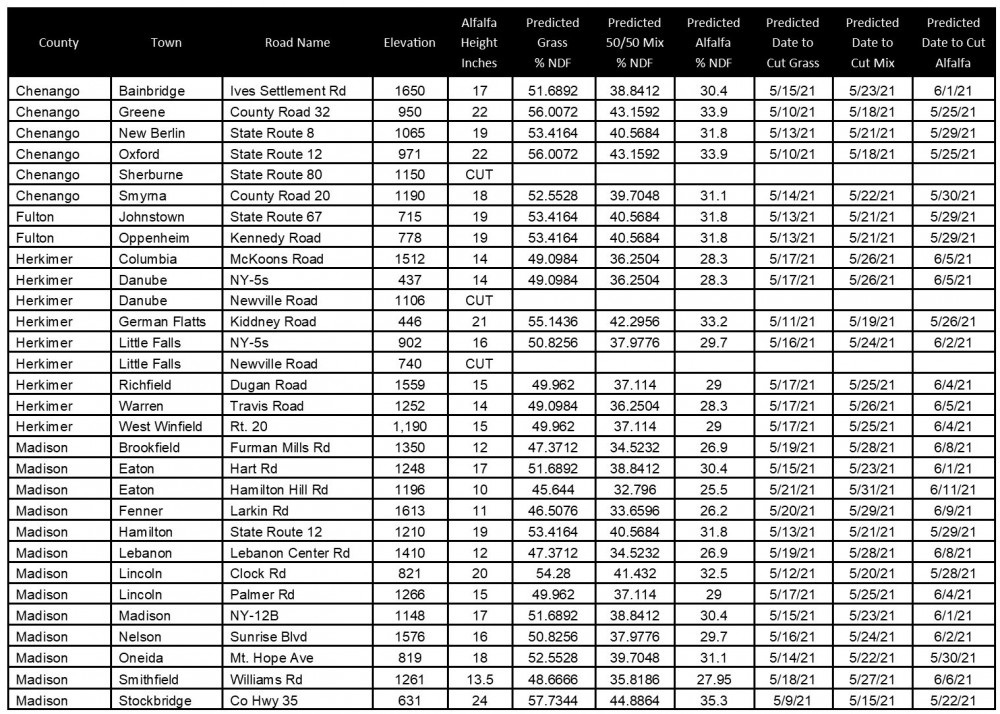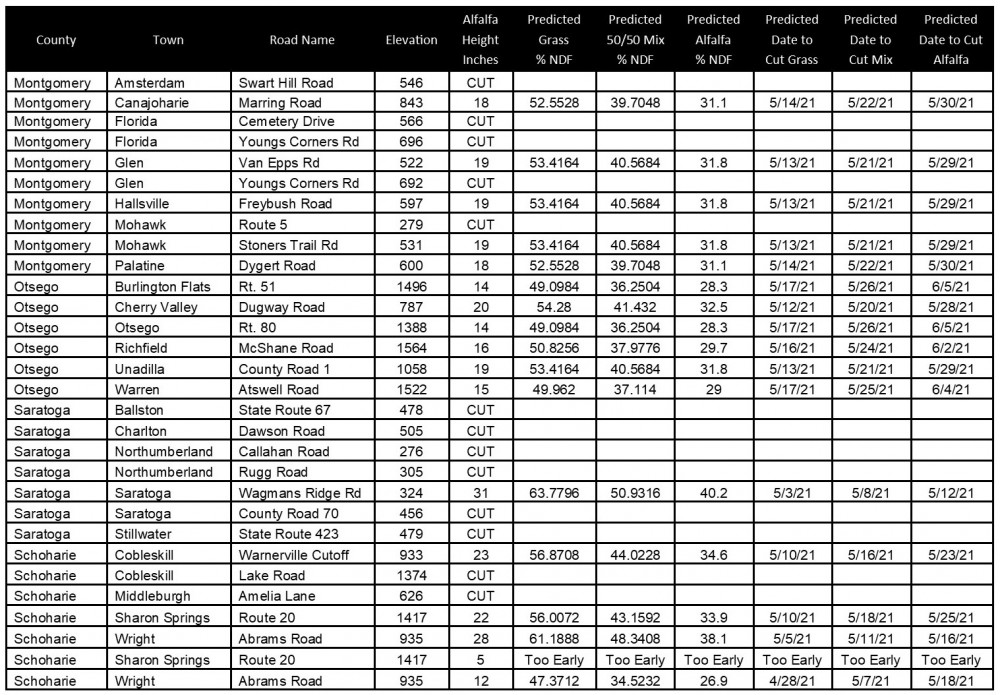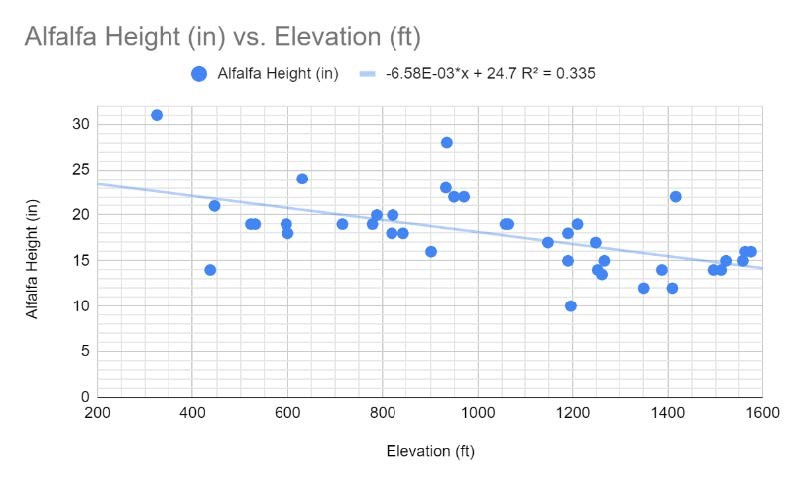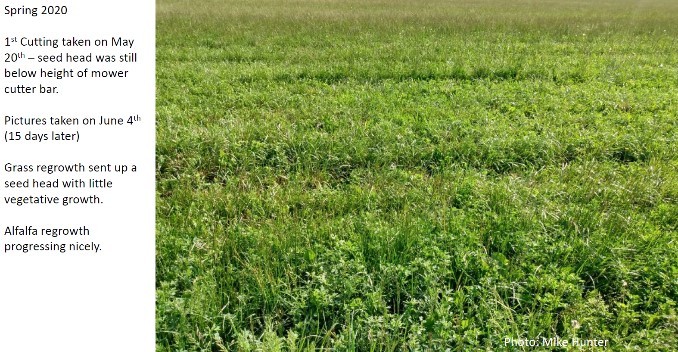1st Cutting Forage Quality Update ~ May 17, 2021
Erik Smith, Area Field Crop Specialist
Central New York Dairy and Field Crops
This is our fourth week of monitoring 1st cutting for quality in 2021. If you are not familiar with our procedures we use alfalfa height to predict Neutral Detergent Fiber (NDF) for alfalfa, alfalfa/grass mixed and grass stands. Alfalfa height has proven to be a reliable indicator of NDF values in the field. Here are numbers that are helpful when using alfalfa and grass height as an indicator of NDF content. In general:
Begin cutting 100% grass stands when nearby alfalfa is 14" tall to achieve the desired 50% NDF.
Begin cutting 50/50 alfalfa/grass stands when nearby alfalfa is 22" tall for the desired 44% NDF.
Begin cutting 100% alfalfa stands when alfalfa is 28" tall for the desired 40% NDF.
To achieve the desired NDF it is necessary to begin cutting at NDF values slightly lower than the desired value assuming some harvest and storage losses which the above alfalfa height values reflect. For example 28 inch tall alfalfa is closer to 38% NDF but you will need to start then to end up at 40% NDF.
Predicted days to cut are based on daily NDF increases for grasses of 1% point, 50/50 mixed stands of .8% points and alfalfa of .5% point. Typically, NDF increases about 0.8 to 1.2/day for grasses expecting the lower end of that range in cooler weather and the higher end in warm. Alfalfa NDF increases about 0.4 to 0.7/day again figuring the lower end of that range with cool temperatures and the higher in warm. See the following fact sheet for more details: Predicting Spring Fiber Content of Forages (folks receiving the snail mail version of our First Cutting Forage Quality Update have received this fact sheet in print).
Below is this week's chart*, but you can use the location and elevation as a guide to conditions that may be similar to your own. Always check your fields to verify your own heights and conditions!


To summarize and maybe make it easier for those whose locations aren't listed, here's a chart showing the relationship between elevation and alfalfa heights across our region. If your location isn't listed, you can roughly estimate your alfalfa's height within a few inches based on your elevation; just follow the line.
As fields are cut, we lose some of the (already modest) predictive power of this chart. This week, the general decrease in alfalfa height is by about an inch for every ~150 ft rise in elevation. But as you can see, lots of variation there, so be sure to check your fields - they are likely to be ready very soon if they aren't already cut!:

Hello sunshine-
Some of us were able to plant a few acres of corn toward the end of April, which has emerged. Spring small grains are up as well, winter grains are nearing maturity, corn is being planted all over, and hay is being cut. We're forecast to have hot, sunny weather through Friday before seeing some thundershowers this weekend, so if you have hay fields nearing their prime, now is the time.
Remember:
When it comes to taking first cut, we need to triage our fields: focus on those that can give us the highest quality now and shift focus away from those that are past their prime. "With the unique spring weather patterns this year, there are likely scenarios where fields are not accessible when the forage is at target maturity. As these fields become over mature set them aside (they likely still have value for non-lactating animals) and focus efforts on harvesting fields that are at target quality." - Betsy Hicks (CCE-SCNYDFC) and Joe Lawrence (PRO-DAIRY). See the following article for a more detailed explanation: Dynamic Harvest Schedules.
And watch the height of the seed head in relation to the height of your cutter bar on annual grasses. Peel the grass leaves down to the center to get a good look at your seed head and make sure it's going to be taken with the cut:

Upcoming Events
DEC Pesticide Applicator Exam
April 19, 2024
Morrisville, NY
New York State Fiber Conference
June 9, 2024
Bouckville, NY
Theme for this year: Quality Matters
Announcements
Cash Rent and Custom Harvest Survey
To date, there is limited information available about rental rates and fees for crop harvesting. Farms can use this valuable information for their farm business planning to help improve decision making and profitability.Farmers Can Join MeatSuite For Free!
MeatSuite.com is a free resource provided by Cornell University where NY meat farmers can create a farm profile and list their bulk (wholes, halves, quarters) and bundled (i.e. Grilling Bundle) meat products.Why should farmers join?
1. It's free and easy!
2. Connect with more local customers. In the past year the MeatSuite.com farm directory had 8,300 visits from New York consumers. Farm profiles get as many as 25 views per month from potential local customers. We also spotlight MeatSuite farms on social media and bring attention and purchases to farms through highlights and giveaways.
How do I join?
Farmers can visit https://www.meatsuite.com/farmers/ to create a free farm profile. You must list at least one product for your farm's profile to go live. You'll also have access to Cornell's free Meat Price Calculator, a helpful tool for pricing your meat to make a profit.
While you're on MeatSuite, check out the "Creating Consumer-Friendly Bulk Meats" publication on the log-in page. It has tips on how to create bulk meat products that are easier for first-time buyers to say "yes" to.
If you have any questions as you create your farm profile or products, we're here to help! Please email Matt LeRoux at mnl28@cornell.edu.




